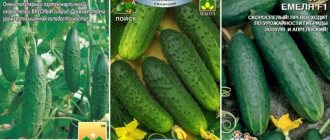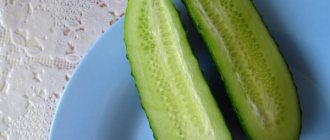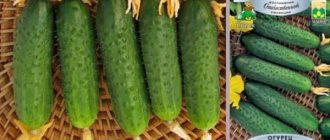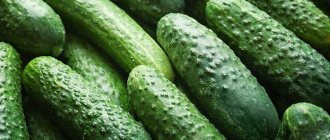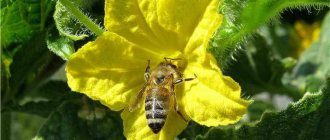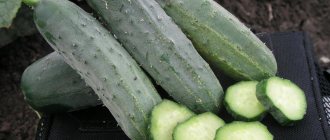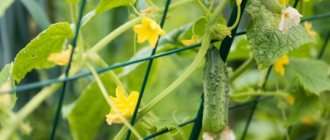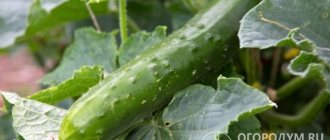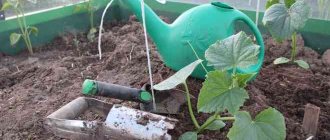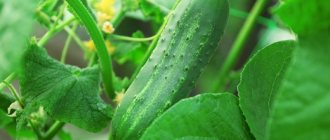Description of cucumbers Boy with Thumb F1
Heterotic hybrid of cucumbers "Boy the size of a Thumb" is the result of breeding work of Russian agro. The variety was included in the State Register of Breeding Achievements of the Russian Federation in 2000. Recommended for planting throughout Russia. Boy-sized cucumbers form an ovary without pollination by bees. In addition to yield and immunity to disease, gardeners note the crop’s resistance to autumn frosts and cool summers in the North-Western region, as well as its excellent taste.
The plant bears fruit both in open and protected ground. This variety of cucumber is successfully grown even on the balconies of city apartments.
According to the description and photographs, the Boy with a Thumb variety has:
- tall and climbing bushes;
- large leaves and inflorescences;
- dense cylindrical greens;
- small dark green fruits;
- cucumber yield from 7 to 14 kg per 1 sq. m.
Harvesting and storage features
The crop can be harvested as it ripens or en masse in July. If cucumbers need to be transported, carefully cut the fruits so as not to damage them. The yield of the variety is 10–14 kg/m². For pickling, collect fruits about 10 cm long. It is advisable to collect fruits daily, which will stimulate further fruiting.
A good quality fruit has a pronounced cucumber aroma, dense consistency, crispy flesh, and uniform color. Specimens without external damage are suitable for storage. They can be stored in the refrigerator in plastic wrap for up to 10–15 days.
Growing cucumbers is not a difficult task at all, and if you grow an early crop, it will become even easier, since there are still too few pests of these vegetables. Put your knowledge into practice, and your plants will definitely please you with a good harvest.
Taste qualities of cucumbers
Boy-sized cucumbers have excellent taste. Ripe fruits have a dense consistency, a pleasant aroma and a characteristic crunch when eaten. The peel of the cucumber is thin, it does not contain any bitter substance, so it does not need to be cut off before using it for food. The pulp of the fruit is tender and contains many sugars and microelements.
Boy's finger cucumbers grow small - up to 11 cm, rich dark green color. There are characteristic tubercles on the peel.
Thanks to their dense consistency, cucumbers tolerate transportation well: they do not wrinkle or crack.
This crop is good to pickle and pickle in jars. Processed cucumbers retain good taste. In the marinade they remain dense and crispy, the flesh does not fall apart and keeps its shape.
Pests and diseases
This hybrid is resistant to common crop diseases. But if the growing conditions are inappropriate, Thumb Boy’s immunity decreases. Therefore, preventive spraying of the bushes should be carried out several times during the growth of green mass. For this, it is recommended to use Ridomil Gold.
The fungicide solution should be applied immediately after preparation.
Important! No cases of pest damage to the hybrid have been recorded.
Pros and cons of the variety
In vegetable salads, Thumb-sized cucumbers bring out the flavor perfectly. The vegetable is not watery, which is important when slicing, but it is also quite juicy and goes well with tomatoes, peppers and aromatic herbs.
The variety is rich in positive characteristics:
- High germination rate. There are practically no hollow seeds in the package. If you follow the rules for growing seedlings, sprouts appear in 99% of cases.
- Early ripening. The first fruiting begins 5 - 6 weeks after germination.
- Extended fruiting period. The harvest of crispy cucumbers can be harvested for about 3 months: thus, almost the entire summer is ensured by regular harvesting of green vegetables.
- High yields. One bush can produce at least 7 kg of harvest per season.
- Taste and appearance of cucumbers. Cucumbers have a high taste both fresh and pickled. The skin of the fruit is not rough, not bitter, and the pulp has a pleasant sweetish taste. Cucumbers grow small and do not tend to grow to the size of a zucchini: if the cucumber is not picked in time, it will stop at a size of 11 cm in length and will only thicken.
- High endurance. The variety can withstand temperature changes, long-term lack of watering and pest attacks.
- Good adaptability. Hybrids are successfully grown in open ground, in a greenhouse, under film, and in an apartment - on a balcony or even on a windowsill.
The unique hybrid variety Little Thumb has small characteristics that are difficult to classify as obvious shortcomings. For example, the harvest of cucumbers "A Thumbnail" from an apartment window sill is inferior to the harvest grown in greenhouses, since the variety is very light-loving and does not bear fruit well in insufficient light.
Description and characteristics of the variety
The variety is self-pollinating and does not require insects.
The hybrid is characterized by tolerance to cool weather conditions and resistance to short-term frosts. Cucumber is actively cultivated in covered and unprotected beds, and at home - on balconies and window sills. The hybrid has the following features:
- tall bushes (central trunks reach 2.5-3 m in length);
- moderate climbing;
- female type inflorescences;
- abundant bunched ovaries.
The hybrid is early. The first greens are picked 38-42 days after germination.
The fruits are characterized by the following characteristics:
- length 8-9 cm;
- diameter 2.5-3 cm;
- weight 70-90 g;
- elongated oval shape;
- numerous small tubercles;
- white moderate pubescence;
- dark green color;
- small longitudinal stripes.
The fruits are used universally. Fresh cucumbers are cut into salads, snacks, and crispy slices are added to sandwiches, first and second courses. When canned and pickled, the fruits retain their neat shape and dense texture.
Taste qualities
Zelentsy have a pleasant taste. The pulp of ripe cucumbers is elastic and crispy, and has an excellent aroma of freshness. The taste contains notes of sweetness and is never bitter. The skin is thin and tender. Cucumbers are a storehouse of valuable minerals, sugars, and vitamins.
Optimal growing conditions
Boy-sized cucumbers are grown from seeds or ready-made seedlings.
The rules for growing this cucumber hybrid are no different from growing other varieties. For seedlings to germinate, warmth and moderate humidity are required. To do this, a seed is planted in the prepared soil to a depth of about 1 cm. The hole is sprinkled with soil and moistened with a spray bottle. For better germination, the seeds are covered with polyethylene to create a greenhouse effect. After the first shoots appear, the polyethylene is removed and the young shoots are cared for.
For good growth, young seedlings need favorable conditions.
- Seeds must germinate in loose soil. Before emergence, the soil must be well moistened.
- Cucumber seedlings love warm soil: for optimal development of the root system, the daytime temperature should be above 20 oC, and the night temperature should be at least 15 oC.
- Seedlings also respond favorably to fertilizing, weeding, and loosening.
Growing
The cultivation technology is not much different from other hybrid varieties of cucumbers. It is possible to plant seeds in open ground using the dry method and the germination method. In the first case, the soil is moistened and fertilized in advance, holes are made no more than 2 cm deep, leaving a distance between them of 22-24 cm. Planting is carried out throughout May. In the second case, cucumber seeds are placed in warm and damp gauze, left for a couple of days in a warm place, and then sown. In both cases, the bed is initially covered with plastic film. After the first shoots, feed with slurry or chicken droppings.
The seedling method of cultivating cucumbers allows you to get the harvest a little earlier. Planting is carried out in special forms or peat pots/tablets. The soil chosen is light and fertile. It is also necessary to take care of proper lighting and timely feeding. Before transplanting, seedlings must be hardened (kept in the refrigerator for 1-2 days).
The seedlings are planted in the ground a month after sowing the seeds in the container.
Growing cucumbers Boy with Thumb
Growing cucumbers the size of a boy's finger is possible directly in open ground, or in seedlings.
Regardless of the chosen planting method, the seeds must be soaked in a weak solution of potassium permanganate. This will rid them of pathogens, fungi and bacteria. In addition, the experience of gardeners indicates better germination of disinfected seeds.
Direct planting in open ground
Treated seeds are planted in open ground in established warm weather. Cucumber beds are enriched with mineral fertilizers.
In a broken ridge, the soil should be loose and free of lumps, stones or old roots.
A string is pulled along the prepared bed and furrows are drawn with it, the distance between which should be 60 - 70 cm. Before sowing, the holes are well fertilized with manure and spilled with water. Sow 1 - 2 seeds into the formed furrows, taking steps of 20 - 30 cm.
It is necessary to remember the high germination rate of hybrid cucumber seeds. Seedlings of the Thumb Boy variety are not thinned out, so the seeds should not be sown frequently.
Growing by seedlings
Grown seedlings are planted in the ground when the plants reach a height of 20 - 25 cm, and at least 4 - 5 leaves should form.
Before planting, carefully remove the plant from the container, trying to handle the fragile roots with care. Many gardeners grow seedlings in a biodegradable natural container, which, along with the root ball, is planted in a prepared hole. The distance between young cucumbers should be about 30 cm for free growth and development of shoots.
The planted seedlings are watered and covered with a special covering material or an empty plastic bottle. In such a mini-greenhouse, the root system quickly adapts to new conditions.
After a week, the protective material can be removed and the cucumbers can be watered with nitrogenous fertilizers.
Watering and fertilizing
The Thumb Boy variety bears fruit well with moderate watering. Young plants need more active hydration than mature ones.
Aqueous solutions of wood ash, superphosphate, nitrogen and potassium are ideal as fertilizers. For convenience, garden departments sell ready-made mineral fertilizer complexes in ampoules, powder or water emulsion.
Formation
Cucumber bushes of the Boy-sized variety grow large in greenhouses, with a lot of greens. Without a garter on wet soil, the plant will quickly rot and die. To distribute sunlight evenly, grown bushes must be tied to supports.
Cucumbers of the Thumb-sized cucumber variety are unpretentious in caring for and do not require additional effort. Mature plants do not need to be pinched. To avoid infection, be sure to remove old wilted and yellowed leaves.
Protection from diseases and pests
When developing hybrid cucumbers, Russian breeders took care to create a disease-resistant variety: it is not susceptible to cucumber mosaic, powdery mildew and cladosporiosis.
In order to prevent diseases and for successful harvesting, the following rules must be observed:
- Be sure to treat cucumber seeds with a weak solution of manganese before planting.
- Plant seeds or seedlings in warm soil.
- Regularly weed cucumber bushes to remove weeds that serve as carriers of diseases.
- Fertilize with mineral fertilizers and water the plants in a timely manner.
Growing and care
Cucumbers from “Manul” are undemanding in care and require compliance with the rules of traditional cultivation:
- watering with warm water, irrigation at least once every 2-3 days (drip method recommended);
- fertilizing 4-6 times over the entire period, alternating organic matter and minerals;
- loosening and weeding, spreading a layer of mulch from straw and hay;
- tying to a mesh or trellis structure, forming and pinching side branches.
When grown on a windowsill, the bushes are planted in 3-4 liter pots, which are filled with fertile, drained substrate. Drainage made of expanded clay or small stones is laid at the bottom. Sow 2-3 seeds per pot. A support for the garter is installed nearby.
Sowing seeds: growing without seedlings
The hybrid “Tom Thumb F1” works well when grown without seedlings. In this case, it is allowed to use not only dry, but also pre-soaked cucumber seeds. You can sow in open ground throughout May. In this case, the following recommendations must be observed:
- the seeds must be of the same size and full-bodied;
- when grown using a trellis, the seeds should be sown in nests, 20 cm apart;
- The row spacing for a nested sowing pattern should be 35-40 cm;
- the depth of sowing seeds in moist soil is no more than 2 cm and may vary slightly depending on the type of soil;
- after the first pair of true leaves appear, the seedlings should be thinned, leaving a distance between plants of approximately 22-24 cm;
- after thinning, the seedlings must be fed with a solution of slurry or chicken droppings; further fertilizing is done with mineral fertilizers applied immediately before watering the plants with warm water.
Caring for the cucumber variety Finger
Finger care is no different from caring for all types of cucumbers. To ensure that the plant bears as many fruits as possible, the bushes are regularly watered and fed. After heavy rain and regular watering, the soil is loosened. Weeds are removed as necessary.
Despite the fact that cucumbers love moisture, you should not overwater the plants. Due to the constant exposure of the roots and stems to water, plants become susceptible to fungal diseases.
During the flowering period, cucumbers are watered only with settled water, the temperature of which is close to the ambient temperature. Due to temperature shock, the plant can shed some of its ovaries, thereby greatly reducing the yield.
Articles for gardeners and gardeners
Lunar calendar for planting tomatoes for seedlings in 2021
Lunar calendar for planting pepper seedlings in 2021
Lunar sowing calendar for April 2021 for gardeners and gardeners
Lunar sowing calendar for May 2021 for gardeners and gardeners
Agricultural technology for growing tomatoes Lady fingers
Planting seeds and growing tomato seedlings does not pose any particular difficulties. The main thing is to prepare the seeds first, which will allow you to remove empty ones and guarantee germination.
Working with seeds
Prepare the seed material for planting in advance - treat it with growth stimulants, which will allow disinfection. Therefore, in the future the bushes will not suffer from diseases and will produce a good harvest.
Additionally, you can soak the seeds and place them on a cloth or napkin, wetting it periodically. When the seeds sprout, replant them in the ground, and throw away those that remain without sprouts.
Growing seedlings
Plant seeds to obtain seedlings approximately in mid-March (50-60 days before the planned planting in the ground). Depending on the climate zone you live in, select the optimal timing.
The landing procedure consists of several stages:
- Prepare the soil and boxes for planting. Treat the soil with a manganese solution for disinfection. You can also use ready-made purchased soil.
- Plant the seeds to a depth of no more than 1 cm, moisten the soil slightly, cover the boxes with a layer of film and place in a warm place.
After about a week, the first shoots appear, after which remove the film and lower the temperature to +15 degrees. Don’t forget about the need for proper lighting; install additional lighting. When the third leaf has formed, pick the seedlings into separate containers. Remove the tip from the central root to speed up its development. About 14 days before planting the seedlings in a permanent place, begin hardening them - take them out into the fresh air for a couple of hours every day.
Planting seedlings in the ground
Approximately on the 50th day of seedling growth, it needs to be planted in open ground, but not earlier than in early May.
Follow the following procedure:
- plant early in the morning before the heat sets in, making it easier for tomatoes to adapt to a new location;
- replant the plants along with the soil from the cup to the same depth;
- if the plant is too tall, plant it at a slight slope, so that along with the root, the extra stem will be underground;
- leave a distance of about 50 cm between the rows, at least 30 cm between the bushes;
- follow the scheme - for 1 sq. m no more than 6-7 bushes.
Main characteristics of finger cucumbers
- Early ripening.
- Bee pollinated.
- Indeterminate (the stem grows throughout the growing season).
- High resistance to powdery mildew.
- High yield.
Since this species was originally intended for planting in open ground, it easily tolerates spring-autumn temperature changes, although it is not frost-resistant. However, both seeds and seedlings are planted only when the soil warms up during the day to a temperature of at least 15 degrees during the day and does not drop below 8 degrees at night. After planting, the bed is wrapped in non-woven material, film, or a mini-greenhouse is built to protect the young shoots.
cucumber finger
Important: Even if a cucumber variety is classified as frost-resistant, this does not mean that it can be planted in winter or during frosts. The minimum temperature that an adult plant can withstand is not lower than 4 degrees (for frost-resistant species the permissible temperature is 2 degrees) for no more than 5 days
At this temperature, the growth of the stem and fruit stops. If the cold snap lasts longer, the cucumber will die.
This variety of vegetable, like its hybrid brother the Thumb Cucumber, produces high yields. Throughout the entire growing season, it is possible to obtain about 7 kg of harvest from a bush. After the first shoots appear, this early-ripening varietal cucumber begins to bear fruit in 38-50 days and yields evenly over two months. Cucumber ovaries are formed in bunches. The body of the fruit is green, with small white veins. The surface has a slight bumpiness, there are almost no needles. Weight can reach 110-120 g, length 10-12 cm. Taste without bitterness. Another undoubted advantage is that Palchik cucumbers tolerate transportation perfectly.
Please note: The fruits are crunchy, dense, and aromatic when tested, but they must be collected on time, avoiding overripeness, otherwise the taste will deteriorate. Another feature of the plant is its flowers, mostly “female.”
They are pollinated by bees, so it is better to cultivate cucumber beds in a quiet, windy place, with some shade. These vegetables do not like direct sunlight, preferring diffused light, because the sun can burn their delicate leaves. And cucumber growth mainly occurs in the dark. Cucumbers planted in a greenhouse have the opposite principle of care. Flowers, on the contrary, must be well ventilated for pollination, or you can place a beehive in a greenhouse
Another feature of the plant is its flowers, which are mostly “female”. They are pollinated by bees, so it is better to cultivate cucumber beds in a quiet, windy place, with some shade. These vegetables do not like direct sunlight, preferring diffused light, because the sun can burn their delicate leaves. And cucumber growth mainly occurs in the dark. Cucumbers planted in a greenhouse have the opposite principle of care. Flowers, on the contrary, must be well ventilated for pollination, or you can place a beehive in a greenhouse.
The leaves of this variety have a standard appearance, they are dark green in color. In the agricultural directory, the variety is described as vigorous, medium-branched. The cane of the plant can be very tall. The stem grows up to 1.5-2 meters, so it needs a garter or trellis, which the whip will wrap around like a vine. This will make caring for the plant and harvesting much easier.
Tip: Cucumbers require moist, light soil, without stagnant water. A good result is obtained by the ratio of sawdust, peat, humus and ordinary soil in equal parts.
